#anachronornis
Note
do you have a masterpost of "ty lee comes from crypto-air nomad" posts? I'm fascinated by this idea and want to read everything I can but I can't find where it started 😭
i feel like this is a question better posed to @kyoshi-lesbians, who, at least in my book, is the leading expert in ty lee studies (among other things). that said, i can definitely synthesize the argument (and why i find it cogent and persuasive), even if i don't actually know from where the theory originated (but i'm sure that if you look up "ty lee air nomad you'll immediately be directed to an old reddit page or fan forum from years ago; it's a "theory" that goes way back).
firstly, ty lee's appearance is distinctly "air nomadic" in a way no one else's is. save for aang, of course. she and aang do bear an uncanny resemblance. everyone else in the fire nation has yellowish brown eyes, for example, while ty lee, like aang, has charcoal greyish brown eyes. and they also have similar (round and cute) facial features, similar expressions, similar vibes. similar dispositions...
ty lee does not "have the personality" of a ruthless fire nation soldier, despite acting as the princess's right hand who takes out more opponents than pretty much everyone else put together. ty lee acts like an airbender, flirty and flighty. her relentless optimism and goodwill and cheer is decidedly a mask, but it is a mask she adopts adeptly. even if she is performing, she nonetheless performs the "aang" function of her respective group.
ty lee presents herself as more spiritually attuned than other people in the fire nation, who outright disrespect the spirits and spirituality. her constant talk of auras is likely a calculated move on her part, as nearly everything is, to make her seem silly and trivial, because she thrives best when she goes underestimated. but her talk of auras also has to come from somewhere, and seeing as literally no one else mentions auras once throughout the entire show, ty lee's sources are clearly scarce.
ty lee also fights like an airbender. despite generally taking the offensive, ty lee nonetheless exhibits a graceful, acrobatic quality when in combat. she never kills anyone either, merely incapacitates them momentarily. and when she is faced with stronger than typical opponents, she usually relies on her skills as an acrobat by taking the aerial advantage. note her ability to jump incredibly high, such as in "the chase," or her ability to run along a moving cable wire in "the boiling rock." ty lee's skills go beyond merely being a good acrobat. she's incredible. and perhaps even exhibiting some latent airbending skills she inherited from her ancestors.
ty lee's air nomad ancestry coheres really well with her arc as a character. imagining that her family of genocide survivors hid in the heart of the fire nation and assimilated into the imperialist culture that sought to exterminate them makes her own role that much more impactful. there's already a beautiful parallelism to the fact that ty lee is an acrobat and performer who contorts herself to suit the desires of others and performs obsequious loyalty for her own survival, but an extra layer of depth is added if she's also assimilating into the royal court by reducing herself and hiding her true feelings and motivations, just as her family did.
i see ty lee's ancestors as having assimilated into the imperial core out of fear, but over the generations, genuinely being subsumed into fire nation culture, with the desire to social climb a natural extension of their patriotism. but there are also still facets of ty lee's ancestry, whether genetic or otherwise, that have remained in traces. the generational trauma, for example, definitely reflects why her parents had so many children. and the fact that she's constantly torn between two worlds, as a genocide survivor who also directly serves the imperialists who murdered her ancestors, represents her internal struggle as someone who desires freedom of expression and the choice to assert her individuality, but is also forced through circumstance into lying and deflecting and manipulating (which, to be honest, is also the air nomad way) for the sake of survival.
surviving is ty lee's number one priority, in a way it just isn't for mai. mai and ty lee both come from social climbing families (although i've always assumed that mai's family is far wealthier than ty lee's) but mai is also depressed and frustrated and bored out of her mind. and even though she was raised in a family that forced her to don a mask and reduce herself and perform a passive model of femininity, she also has no problem stating aloud how she's feeling and what her limits are (with the exception of when azula gives her a veiled command as a test, and mai has no choice but to obey).
mai has the privilege of knowing that the stakes don't really matter, which she all but states when she claims that she grew up in luxury and opulence, and always had everything handed to her. which isn't to say that she led a perfect, easy life. she wouldn't be as depressed and repressed as she is if there weren't factors actively harming her, but she still chooses to join azula by choice, even if it's really only the illusion of choice between two awful options, whereas ty lee has to be coerced through violence.
mai kind of has a "fuck it we ball" attitude and doesn't really seem to care about her own safety (if anything, she's more concerned with comfort), whereas ty lee would do anything to ensure her survival. and that kind of mentality illustrates how she differs from most of the fire nation elites, who were inculcated into imperial privilege and never really considered what prioritizing survival even entails (zuko learns that lesson the hard way). ty really exhibits the mentality of the genocide victim/colonized subject through her prioritization of survival in the face of what to mai is a problem, but to ty lee is an existential threat.
whether or not ty lee even recognizes that her desperate desire to live comes from a place of generational grief and trauma is another story, but i do think there is something to be said for the fact that descendants of genocide survivors can feel that grief as it has been passed down to them. i think ty lee feels it, and i think that it motivates her to do whatever it takes to live, because above all, she is a survivor. and even if she has to assimilate and manipulate and cut away every part of herself that's real and authentic and true, she will do it (until she doesn't). and that's also, incidentally, what makes her such a great foil to aang.
#i hope this answers your question!#anachronornis#asks#analysis#ty lee#maixtylee#aang&tylee#aang#mai#air nomad ty lee#i should make that a tag....#also river if u have anything add please feel free#i love ty lee she is the specialest insane girl she is everything
167 notes
·
View notes
Text
The Story of How I Helped Name Anachronornis
Story Time!
So, Dr. Houde - heretofore referred to as Peter - had been trying to describe this bird for AGES. Ages. Longer than I've been alive. But roadblocks have hit him at every turn - including multiple instances of unethical peer review practices
Anyways, I join his lab and he knows I need to publish, so he puts me on the project mainly on the phylogenetic work, because of course that's what I ended up doing
(I also was in charge of a few other things but they are boring or didn't work out)
As we are working, the tentative name for the bird is "Anhimops", which you'll note eventually became its species name
But I couldn't Un-See It (you'll know in a sec)
So
I email my very new advisor
Me: "Hey Peter, how attached are we to Anhimops?"
Peter: "Not very, why?"
Me: "Well, it's just... I can't unsee it as "Animorphs""
Peter (direct quotation): "What the Hell is an Animorphs"
Me: > sends a google image search link
Peter: ".... okay I'll come up with another name"
And from there, we now have the (much better name) of Anachronornis! With anhimops still thrown in for funsies. So that's the story of how I helped to stop a very unfortunate name happening for this wicked cool new dinosaur.
Also, now i get to say "what the hell is an animorphs" on a regular basis, because its hysterical. Win-win
308 notes
·
View notes
Text
Fossil Novembirb: Day 5 - It's Getting Hot in Here

It's the late Paleocene, and the climate is red hot. And it'll get hotter still. It's the start of an event called the Paleocene-Eocene Thermal Maximum, or PETM. At this moment, the Earth's climate warms very rapidly, and it'll gets really warm. How warm? Warm enough for rainforests in Europe, and for towering cypress swamps to grow in the Arctic. And as for these birds living in Paleocene Wyoming, their world is a steaming hot tropical wetland.
Primoptynx: One of the earliest known owls, and was quite large. Unlike modern owls it had talons more like a hawk, and it hunted during the day.
Sandcoleus: An early relative of mousebirds, and a climbing opportunistic omnivorous forest dweller.
Anachronornis: A peculiar kind of waterfowl, related to ducks and bearing a striking resemblance to the screamers of South America.
Paragrus: Despite its name, this is bird is not related to cranes. Instead it belongs to a group of flightless birds called Geranoidids, which are related to ostritches.
Lithornis promiscuus: An early relative of Palaeognath birds like ostritches and emus. Unlike most modern paleognaths, it could fly for long distances and even soar.
Lithornis plebius: Another Lithornithid, and like all lithornithids, had a long sensitive beak for probing insects from soil and leaf litter.
#Fossil Novembirb#Novembirb#Dinovember#birblr#palaeoblr#Birds#Dinosaurs#Cenozoic Birds#Primoptynx#Sandcoleus#Anachronornis#Paragrus#Lithornis
45 notes
·
View notes
Text
Anachronornis anhimops Houde et al., 2023 (new genus and species)

(Skull [A–Q, S], rib fragment [R], and back vertebrae [T] of Anachronornis anhimops [scale bar = 1 cm], from Houde et al., 2023)
Meaning of name: Anachronornis = bird out of time [in Greek, referring to the late occurrence of a form similar to the expected appearance of the last common ancestor of modern waterfowl]; anhimops = Anhima [genus of the extant horned screamer] face [in Greek]
Age: Paleocene–Eocene (Thanetian–Ypresian), 55.8–56.22 million years ago
Where found: Willwood Formation, Wyoming, U.S.A.
How much is known: Partial skeleton of one individual, including a nearly complete skull and forelimbs.
Notes: Anachronornis was likely a close relative of modern waterfowl, which are divided into two major lineages: Anhimae (the screamers, which have slightly hooked, somewhat chicken-like bills) and Anseres (the duck- and goose-like waterfowl, which have broad, spatula-shaped bills). It exhibits a mixture of features characteristic of both of these groups, with the shape of its skull being especially screamer-like. It may therefore represent a form closely resembling the last common ancestor of all extant waterfowl, which would make it a very important discovery for understanding how modern ducks and geese evolved.
The type specimen of Anachronornis had been mentioned in previous scientific literature starting in the 1980s, but was left undescribed until now. Anachronornis may have foraged near water, like modern waterfowl, though it does not appear to have been particularly specialized for swimming or wading.
Reference: Houde, P., M. Dickson, and D. Camarena. 2023. Basal Anseriformes from the early Paleogene of North America and Europe. Diversity 15: 233. doi: 10.3390/d15020233
#Palaeoblr#Birblr#Dinosaurs#Birds#Anachronornis#Paleocene#Eocene#North America#Galloanserae#2023#Extinct
78 notes
·
View notes
Photo
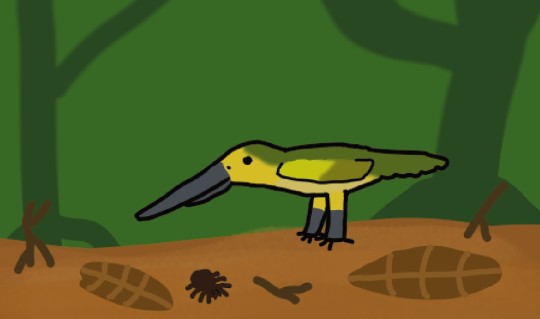

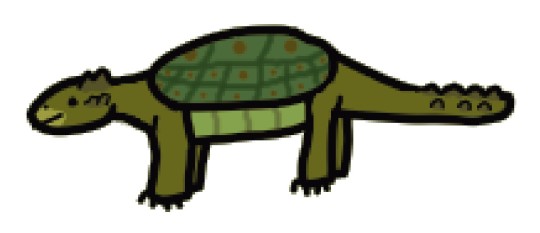
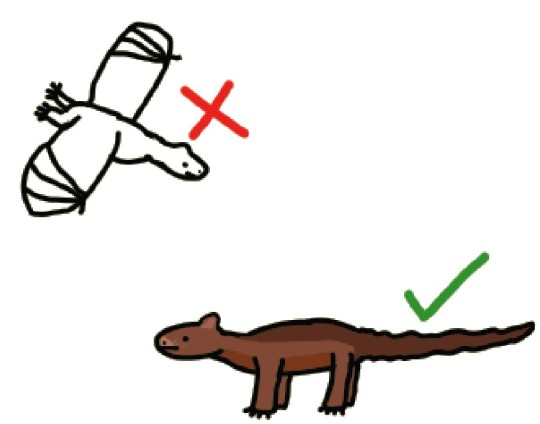
Flocking Together
Scimitar billed nukupu'u
Anachronornis
Warkalania
Ichthyoconodon
3 notes
·
View notes
Text
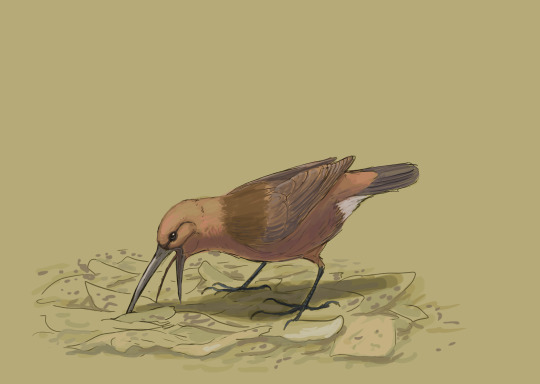

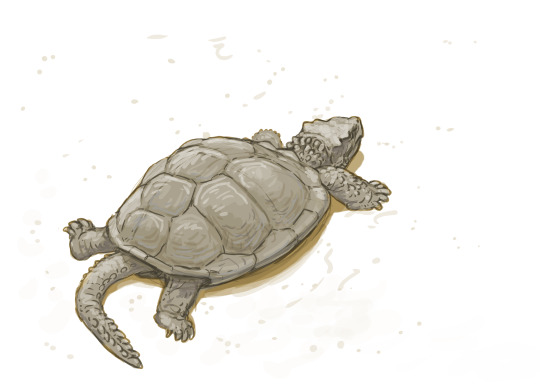

Forgot to post here
Results from the Flocking #paleostream! Scimitar billed nukupu'u, Anachronornis, Warkalania, Ichthyoconodon.
215 notes
·
View notes
Text
Fossil Novembirb, the first nine days
Hello World. I never thought I'd be on this site, but here I am. This blog was created for the purpose of participating in a-dinosaur-a-day's Fossil Novembirb. Fossil Novembirb is a yearly art event founded by Meig Dickson, a vertebrate palaeontologist who, as far as I can tell, studies dinosaurs, especially theropods. Don't fight me or em over birds being theropod dinosaurs. Neither ey nor I want to have this conversation, so enjoy the art!
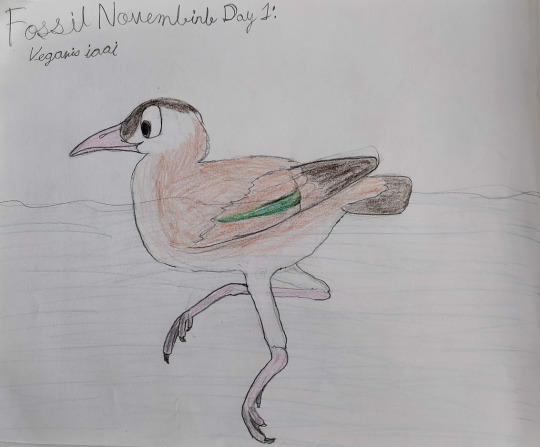
I started off my Fossil Novembirb with Vegavis iaai. What makes this fluffy anseriform special is that we found a fossilised syrinx (avian voice-maker) belonging to one of these, so we can reconstruct their sounds. This Vegavis was coloured based on a bunch of anseriforms that are alive today, like ruddy shelducks and cotton pygmy geese.

For Day 2, I did a bit of spec evo and pulled out a scientific name I told myself I'd assign to a newly-discovered fossil genus. This sketch has a Serina-like text description for Phantasmavis.

Tropicbirds! I chose to draw Clymenoptilon because I was hoping "tropicbird" meant "brightly coloured bird". Even though they aren't that brightly coloured, they're still cool. And Kumimanu (approximately to scale in this drawing) didn't really have the obligation to be black-and-white like most extant penguins (because Inkayacu), so I went... mild-wild with the colours.
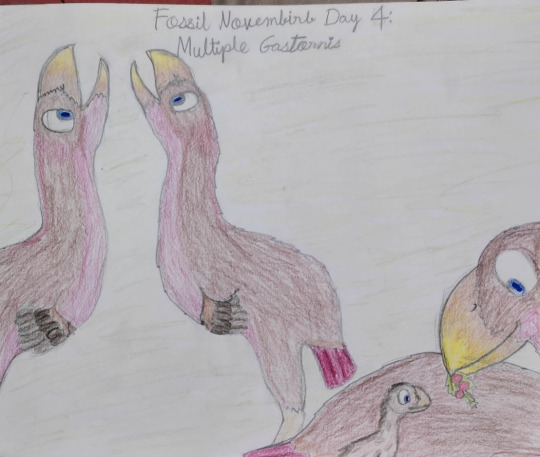
No... one's... tall like Gastornis, no one calls like Gastornis! In the bottom right, no one feeds small like Gastornis!
I've seen the "Andy's Prehistoric Adventures" episode featuring these megafowl, realised it was Walking With Dinosaurs with a human inserted, and drawn a mildly speculative colouration for these Gastornis. To the left, two adults have their necks out towards each other and are calling into the sky. Whether this is courtship or a challenge, nobody knows. But a calmer scene happens in the bottom right, where a mother shows her chick red berries on a branch to show them that it is food.
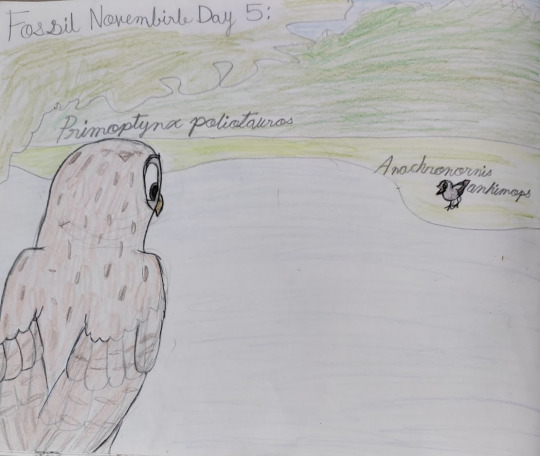
"Don't make me fly up there, you punk!" is one way to interpret the screamerduck Anachronornis' call in the direction of the Primoptynx owl. This scene unfolds in the Palaeocene-Eocene Thermal Maximum ecosystem of the Willwood Formation before it was rock.
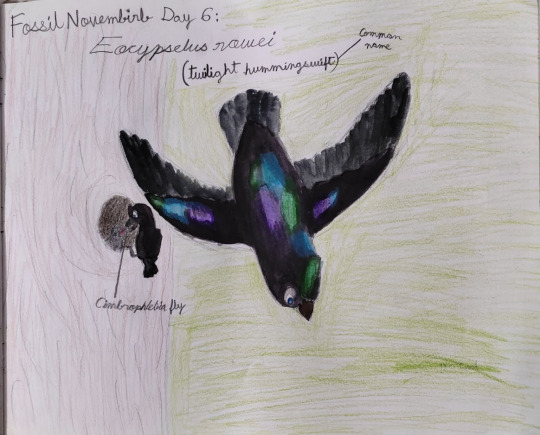
It's a twilight hummingswift! We know the colour of this iridescent little birb from the Danish Fur Formation. I watched a tutorial on painting iridescence, but I'm not really satisfied with the parent feeding their chick to the left of the flying Eocypselus rowei. It's hard to see, but there's a baby hummingswift being fed a Cimbrophlebia scorpionfly.
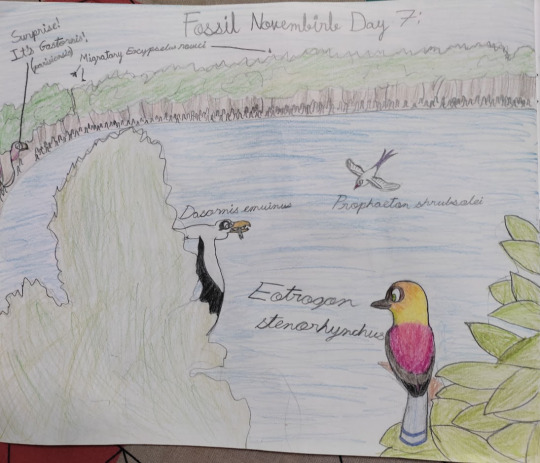
London Clay has a lot of plant fossils. Not all of them are listed on Wikipedia, but there's a photo of a pencil-root mangrove seed listed. Featuring a speculatively-coloured Eotrogon, a Dasornis carrying away a mackerel, and a Prophaeton just gliding, and repeat telecasts Gastornis parisiensis and Eocypelus rowei, Eocene London was a birder's dream (believe me, I'm a kinda-birder).
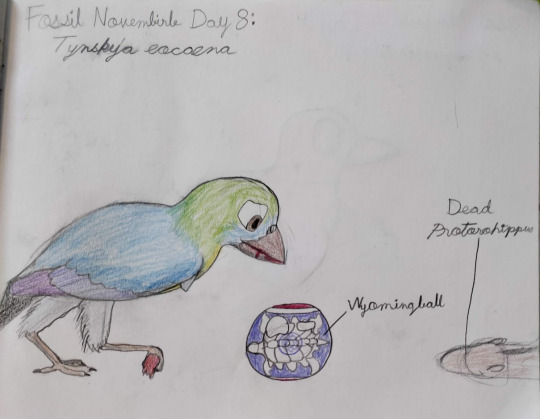
This Tynskya art was somewhat late, rather dissatisfactory, and mildly rushed. I had an exam the next day. Don't judge me.
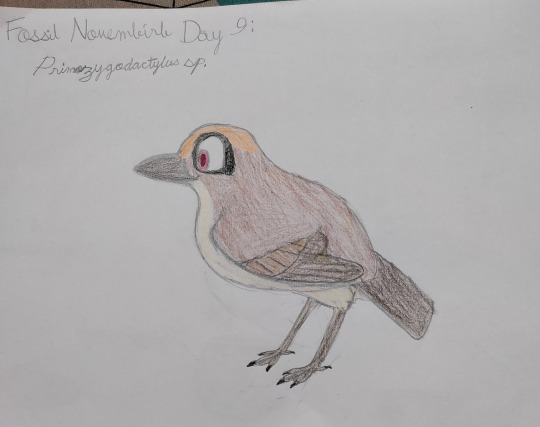
And here's a better Primozygodactylus! I couldn't tell the specific species because it wasn't listed for the Wikipedia image. But here we are: a bird that gives off ashy prinia/sparrow/orange-headed thrush vibes.
This concludes the first nine days! I don't know if I'll be doing the tenth because nobody's giving me straight answers about the palaeobotany of the Green River formation.
Enjoy!
#fossil novembirb#dinosaur#birds#paleoart#this site is as chaotic as it seemed when I first anonymously browsed eir blog#paleogene#palaeogene#eocene#cenozoic#maastrichtian
14 notes
·
View notes
Text
If multiple pick favourite pls!
If other pls comment, couldn't add show results otherwise, as would have to drop one
Some options are lumped together as not enough spaces. Sorry reptiles and amphibians!
Also rabbits and birds are my fave so before dogs and cats :b
@robotslenderman
@themarginalthinker
@anachronornis
11 notes
·
View notes
Text
Anachronornis vs Conflicto
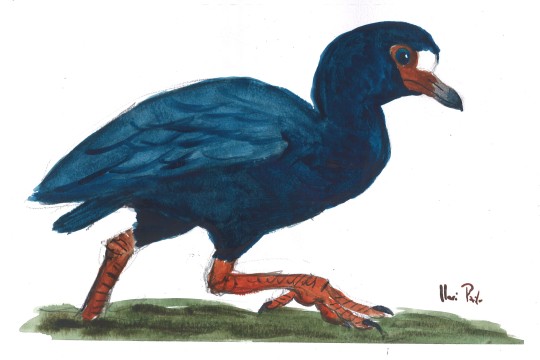

Factfiles:
Anachronornis anhimops

Artwork by @otussketching, written by @raptorcivilization
Name Meaning: Anachronistic screamer-faced bird
Time: 56.22 to 55.80 million years ago (Thanetian stage of the Paleocene epoch, Paleogene period)
Location: Willwood Formation, Wyoming, United States
Ducks - they’re everywhere nowadays. But they weren’t always everywhere. And they didn’t always look like ducks. Anachronornis was an early anseriform (an early duck, if you will) which in life would have looked a lot like a modern screamer. In particular, Anachronornis’s beak looks a lot like that of the living screamer, suggesting that anseriforms ancestrally had this pointier beak shape (which was retained by closely-related galliforms), and the spatulate shape of modern ducks is a much more recent evolutionary innovation. Other aspects of Anachronornis’s anatomy more closely resembles those of spatula-billed Paleogene anseriforms, however. And this makes our understanding of morphological evolution in anseriforms that much muddier. In any case, Anachronornis seems to be a stem-anseriform - perhaps less closely related to modern anseriforms than the Tall Boys, presbyornithids, are - but these early ducks are scrappy enough that the phylogeny could change without warning. Interestingly, Anachronornis lived not long before the Paleocene-Eocene Thermal Maximum - that’s quite a late appearance for something in that part of the tree. Hence the genus name. Anachronornis lived near water in wet subtropical forests, alongside lithornithids, sandcoleids, a lizard, and various mammals. Based on the morphology of the bill and hindlimbs, it may have fed on floating aquatic plants while wading in shallow wetlands - doesn’t seem to have been a dabbler or diver like many modern ducks.
Conflicto antarcticus

Artwork by @otussketching, written by @zygodactylus
Name Meaning: Contradiction from Antarctica
Time: 65 million years ago (Danian stage of the Paleocene epoch, Paleogene period)
Location: Seymour Island, López de Bertodano Formation, Antarctica
The evolutionary history of the fowl - chickens and ducks - is a controversial one, owing in no small part to the sheer diversity of basal taxa from the Galloanseran group. Existing prior to the end-Cretaceous extinction, Galloanserans went through the same adaptive radiation that everything did following the extinction - leading to a wide disparity of animals that show a weirdly diverse mosaic of traits. Conflicto is one of such taxa. Literally occurring in a fossil formation that tracks the transition from Cretaceous to Paleogene, Conflicto appears on the Paleogene side of the boundary, possibly a direct descendant of other Anseriformes that were present in Antarctica in the latest Cretaceous. But it's survivorship is not, in fact, the weirdest thing about it. Conflicto, despite being a stem-anseriform, and thus early on in the evolution of the group, had a weirdly duck/goose like beak. It was similar in structure to the bill of waterfowl, just not as wide. It also had large nostrils, much wider openings than modern ducks and geese. The problem with this is the fact that the earliest branching-off members of Anseriformes - the Screamers - have chicken-like beaks. As such, the original hypothesis for bill evolution in Anseriformes was that they started with chicken beaks, and later the group composed of geese, ducks, and magpie-geese evolved a spatulate bill the one time. However, Conflicto coming prior to the splitting off of screamers and having such a bill throws this idea into question - and this won’t be the last word on the subject, I assure you. Showcasing a partially-spatulate bill makes Conflicto an important piece of the puzzle of anseriform evolution. In its post-apocalyptic world, Conflicto was surprisingly not alone - living in a temperate to subpolar fern forest, it was able to feast on a wide variety of gastropods, bivalves, worms, and echinoids. When it comes to vertebrates, however, Conflicto was alone - the last survivor of a previously vibrant Cretaceous environment.
DMM Round One Masterpost
#dmm#dinosaur march madness#dmm round one#dmm rising stars#palaeoblr#dinosaurs#paleontology#polls#bracket#march madness#anachronornis#conflicto
128 notes
·
View notes
Text
Welp, I am finally published! Say hello to some new birds from the Paleogene!!!
175 notes
·
View notes
Text
ITS ALMOST FOSSIL NOVEMBIRB!!!!!
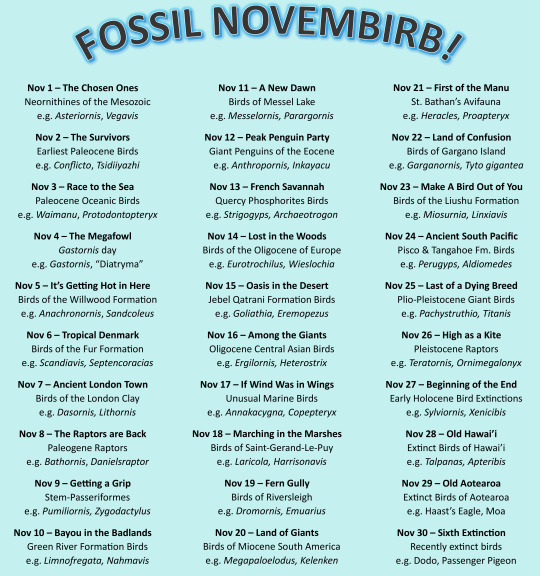
We're going to have a CELEBRATION of FOSSIL NEORNITHINES for this November!!! The extinct members of the only group of dinosaurs we have today!
Each day will have a prompt inspired by the evolution of crown-birds and the amazing forms they have taken over the past 68 million years!
You can respond to each day's prompt however you wish - with drawing and painting, writing, sculpting, music, videos, whatever! Just tag it "#Fossil Novembirb" for me to find it, and it'll get reblogged!
I'm so excited to see the art you guys create!
NOVEMBER 1 - THE CHOSEN ONES
Crown-Birds (Neornithes) known from the Mesozoic Era!
Options include Asteriornis, Teviornis, Vegavis, and "Styginetta"!
These are the only dinosaurs that survived the asteroid!
Theoretically there were also early Palaeognaths and Neoavians - if you want to do some spec evo and hypothesize what you think they might have looked like, go ahead! Follow your dreams!
NOVEMBER 2 - THE SURVIVORS
The earliest birds known after the K-Pg boundary!
Options include Conflicto, Tsidiiyazhi, Australornis, Qinornis, and Qianshanornis!
Birds diverged rapidly after the extinction, so also feel free to dive into spec evo into some of the forms we don't have fossils of!
NOVEMBER 3 - RACE TO THE SEA
The first Marine Neornithines and how they evolved in the early Paleocene!
Includes tons of early penguins like Waimanu, Kumimanu, Sequiwaimanu, Muriwaimanu, and Kupoupou
Also includes the first Pseudo-toothed bird, Protodontopteryx, and the earliest known Tropicbird, Clymenoptilon!
RISE OF THE PENGUINS!
NOVEMBER 4 - THE MEGAFOWL
Gastornis (aka "Diatryma", aka "Zhongyuanus") appeared in the mid-Paleocene and was a feature of the Cenozoic landscape until the end of the Eocene - so we have a whole day JUST FOR IT
Show your love for the Megafowl Gastornis! This giant herbivorous bird was fascinating, and has captured imaginations for decades because of it!
Gastornis is also present in many of the ecosystems described below, such as Willwood, Green River, and Messel, so we also just wanted to make sure people didn't keep picking Gastornis over and over again xD
NOVEMBER 5 - IT'S GETTING HOT IN HERE
The Paleocene-Eocene Thermal Maximum was the most dramatic incident of rapid global warming in the world since the Permian... until today!
It majorly affected the evolution of many things, possibly including birds!
The Willwood Formation straddles the time period of the warming, and has tons of birds that were evolving during that time period! So, for this day, create things involving birds of the Willwood Formation!
Options include the flighted Palaeognaths Lithornis promiscuus and Lithornis plebius; the possible stem-Ostrich Paragrus, the early half-screamer-half-duck Anachronornis, the early owl Primoptynx, and the fascinating stem-mousebird Sandcoleus! And many more!
NOVEMBER 6 - TROPICAL DENMARK
Birds of the Fur Formation, one of the best collections of bird fossils from the early Eocene!
Includes such friends as Scandiavis (an early shorebird), Septencoracias (an early roller), Pellornis (an early rail-esque thing), the utterly mysterious Morsoravis, and the early swift-hummingbird Eocypselus!
This was a tropical shoreline environment with many of the first members of major bird groups we see today!
NOVEMBER 7 - ANCIENT LONDON TOWN
Across the shore from Fur was the London Clay Formation, a lush tropical forest near the warm shallow ocean
In addition to a truly alarming quantity of plant fossils, this is a notable locality for early birds, featuring many early members of major groups much like the Fur Formation
Options include Dasornis (a pseudotoothed bird), Pulchrapollia (one of the Parrot-Passerines of Prey), Nettapterornis (another stem-duck), Nasidytes (an early loon), Charadriisimilis (an early shorebird), Archaeodromus (a trogon-like member of Strisores), Eotrogon (an actual early Trogon), Lithornis vulturinus (another flighted Palaeognath), Prophaethon (another early Tropicbird), and Ypresiglaux (an early owl) - and so many more!
NOVEMBER 8 - THE RAPTORS ARE BACK
Turns out "Predatory Feathered Thing with Really Sharp Foot Claws" is a very successful niche - not only was there potentially one right after the end of the Cretaceous (Qianshanornis), but other raptors were some of the first birds to succeed around the world in the Eocene
So this day is dedicated to the early raptors of the Cenozoic!
Any "raptor" from the Paleogene is valid - so here are some suggestions:
Early Cariamiformes (Seriemas and Kin) like Bathornis, Dynamopterus, Strigogyps, and the first potential Terror Birds like Paleopsilopterus
Early Owls like Ypresiglaux and Palaeoglaux
Early Accipitriformes like Horusornis
Early Falcons like Antarctoboenus, Masillaraptor, and Danielsraptor
And of course the ever popular "Parrot-Passerines of Prey" like Tynskya and Messelastur
NOVEMBER 9 - GETTING A GRIP
Half of all living birds are Passeriformes - aka "Perching Birds" - but this wasn't always the case! For most of Earth's history, many other kinds of tree birds were extremely common
Where did this behemoth group of tiny dinosaurs come from? That's the subject of this day's prompt!
In the Eocene, the first birds closer to Passeriformes than to Parrots evolved, and they came in a huge variety of forms! So on Nov 9th, we're going to celebrate this group's interesting beginnings!
Options for this include Parapsittacopes, Eofringillirostrum, Pumiliornis, Psittacopes, Zygodactylus, Primozygodactylus, Psittacomimus, Sororavis, Morsoravis, and Eozygodactylus! Go wild!
NOVEMBER 10 - BAYOU IN THE BADLANDS
Back to specific ecosystems! We're visiting the world-famous Fossil Lake of the Green River Formation!
This environment, during the Early Eocene, was a thriving tropical lake and forest ecosystem filled with tons of early Neornithines as well as mammals and other animals
Gorgeous fossils have come out of this lake, showing truly amazing detail of feathers and other features for these birds!
So here you can feature Prefica (a potential early Oilbird), the flighted Palaeognath Calciavis, the stem-turaco Foro, the early mousebird Celericolius, the possible shore-bird Nahmavis, a potential cuckoo roller Plesiocathartes, the Flamingo-Duck Presbyornis, the early landfowl Gallinuloides, the swift-hummingbird Eocypselus, and the Frigate Bird Trying at being a Gull Limnofregata - and so many more!
NOVEMBER 11 - A NEW DAWN
We're finally moving on to the middle Eocene - and the Messel Lake ecosystem, famous from the first episode of Walking with Beasts (hence the name of the day)!
(If you're going "wait, that episode acts like nothing happened between the K-Pg and Messel, but here you have 10 days worth of stuff" .... yeah. Walking With Beasts skipped the Paleocene and early Eocene and I am... very pissed. Still.)
You know about the tons of early mammals from this tropical lake ecosystem, but it was filled with tons of early birds as well!
There's the early ostrich Palaeotis, the crane-rail Messelornis, the almost-flamingo Juncitarsus, the freshwater Booby Masillastega, the early hoopoe Messelirrisor, Selmes (a mouse bird with stubby toes), the early ibis Rhynchaeites, the early nightbird Hassiavis, the early swift Scaniacypselus, an early roller with known colors Eocoracias, and the early potoo Paraprefica - and many others!
NOVEMBER 12 - PEAK PENGUIN PARTY
As the Eocene continued, penguins achieved true megafaunal status - there were tons of them, they were huge, and they were all over the oceans of the Southern Hemisphere
While penguin diversity never did recover after the Eocene-Oligocene extinction event, this golden age deserves celebration!
Some of these fascinating peak penguins include Palaeeudyptes, Anthropornis, Icadyptes, Inkayacu, Perudyptes, and Kairuku!
NOVEMBER 13 - FRENCH SAVANNAH
As the Eocene began to dry up and cool down, plains grew across the world where the tropical forests once had been
One of the most famous later-Eocene fossil sites for birds is the Quercy Phosphorites location, a French formation with tons of interesting fossil birds!
Here we start to see the early forms of Neornithine Dinosaurs we saw in the Paleocene-Early Eocene diverge and specialize further - often in particularly weird or interesting ways!
So here we have the duck-ish chicken Paraortyx, the secretarybird Pelargopappus, you can also bring back Dynamopterus from earlier, there is the stem-chicken Quercymegapodius as well as stem-parrots like Quercypsitta, the seriema-like Strigogyps, the sandgrouse relative Archaeoganga, Archaeotrogon shows up again, the swift relative Aegialornis, a potential woodpecker relative Sylphornis, and more owls like Palaeoglaux! Lots of cursorial predators in this ecosystem!
NOVEMBER 14 - LOST IN THE WOODS
As the Oligocene dawned, forests did grow back in Europe, though they were now temperate and dry as opposed to the paratropical rainforests of before
This lead to wide diversification of tree-dwelling birds, and so here we will celebrate the birds of the Oligocene of Europe!
We start to really see modern-esque birds at this point, though of course we still have 30 million years of evolution to go!
Here you can feature the early eagle/hawk Aviraptor, the European Hummingbird Eurotrochilus, the seabird relative Rupelornis, the early woodpecker-toucan Rupelramphastoides, the tody Palaeotodus, the proper Passerine Wieslochia, the possible shorebird Turnipax, the mousebird Oligocolius, the hoopoe Laurillardia, and the trogon Primotrogon which we know the colors of!
NOVEMBER 15 - OASIS IN THE DESERT
The Jebel Qatrani Formation of Egypt shows the beginnings of the famous African Grassland animals, as well as many early members of iconic African animal groups such as primates - and, of course, birds!
Taking place in the early Oligocene, this formation was a tropical/subtropical lowland plain filled with ponds and streams and other waterways - aka, tons of swamps surrounded by plains
As such, this place is infested with waterbirds!
Here we have a fossil relative of the Shoebill Goliathia, as well as the jacanas Janipes and Nupharanassa, the giant stork Palaeoephippiorhynchus, the herons Nycticorax and Xenerodiops, and the mystery Palaeognath Eremopezus!
NOVEMBER 16 - AMONG THE GIANTS
Once again we're just fully committing to the Walking With Beasts nostalgia bc these are the birds we wish were in it more okay we said it
Anyways there were some interesting large birds in the plains of the "Land of Giants" episode so picture these guys alongside the Indricothere etc.
In general we're covering the latest Eocene through the Oligocene of Central Asia
Here we have the enigmatic ratites Ergilornis and Sonogrus, the pseudo-toothed bird Caspiodontornis, the owl Heterostrix, and the stem-flamingo Agnopterus
NOVEMBER 17 - IF THE WIND WAS IN OUR WINGS
We all focus on penguins, but over the Cenozoic, plenty of weird birds have evolved for marine life, and boy are they bizarre!
So for Nov 17, we're focusing on the unusual marine birds of the Cenozoic!
This includes any members of the Pelagornithids - aka the Pseudo-toothed birds - as well as the Plotopterids - the Boobies that became Penguins! Pelagornis and Copepteryx are the best known taxa from each, respectively, but there are plenty more!
But that's not all! We have the flightless auks Miomancalla and Mancalla, the large flightless marine duck Chendytes, and who can forget the weird flightless marine swan Annakacygna! Tons of options to choose from!
NOVEMBER 18 - MARCHING IN THE MARSHES
We're now starting our transition from the Paleogene into the Neogene, beginning with the brackish marsh ecosystem preserved at Saint-Gerand-Le-Puy in France!
This Miocene locality preserves a wide variety of birds that are near modern, but not quite - a sort of "uncanny valley" of bird evolution, all set in a somewhat-salty somewhat-not wetland ecosystem
Options for dinosaurs here include Harrisonavis, a transitional flamingo; the early gull/tern Laricola, the enigmatic duck Mionetta, the stork Grallavis, the pratincole Becassius, the swimming-flamingo Palaelodus, the early cormorant Nectornis, the seed-eating pheasant Palaeortyx, the early loon Colymboides, and the mysterious shorebird Elorius!
NOVEMBER 19 - FERN GULLY
Riversleigh is one of the most famous fossil sites in the world, preserving the evolution of the strange and unique animals known today in Australia, during the Oligocene to Miocene transition
Most often, we focus on the bizarre mammals found at Riversleigh, and for good reason - it's a Marsupial Party! - but the birds here are fantastic as well
This ecosystem was a rich rainforest that transitioned over the period of deposition into a semiarid grassland, and covers 20 million years of animal evolution during that transition
Options for birds here include the butcherbird Kurrartapu, the fossil Sittella Daphoenositta trevorworthyi, the Mihirungs ("Demon Ducks") Dromornis and Barawertornis, the Emuwary Emuarius, the early magpie-goose Eoanseranas, the raptor Pengana with flexible ankles, the earliest known species of lyrebird (Menura tyawanoides), the corvid-like Corvitalusoides, the first known cockatoos, the flightless rail-like bird Australlus, the stiff-tailed duck Pinpanetta, the early logrunner Orthonyx kaldowinyeri, and so many more!
NOVEMBER 20 - LAND OF GIANTS
Y'all were probably wondering when we'd get to the Terror Birds and other interesting dinosaurs of South America, so - here we are!
South America, isolated from the rest of the world until the Great American Interchange, featured a wide variety of bizarre and unique animals - not just mammals, but birds and other reptiles as well!
So for Nov 20th, we're looking at the interesting dinosaurs of the "lost continent" during the Miocene epoch, prior to the invasion of North American taxa!
Any Miocene South American Terror Bird (Phorusrachid) is fair game here, so that includes Brontornis, Patagorhacos, Paraphysornis, Devincenzia, Kelenken, Phorusrhacos, Patagornis, Andalgalornis, Psilopterus, Mesembriornis, and Procariama! Note that they did not all live at the same time or even close to each other in location, so do your research on the taxa you pick!
But Terror Birds weren't the only strange dinosaurs in South America at the time! We have the large Teratorn (vulture-like-thing) Argentavis, the *giant* swimming-flamingo Megapaloelodus, the giant Anhinga Macranhinga, the rhea Opisthodactylus, the penguins Palaeospheniscus, Arthrodytes, and Paraptenodytes, the Cathartid Dryornis, the Jacamar Galbula hylochoreutes, fossil Hoatzins like Hoazinavis and Hoazinoides, the giant stork Leptoptilos patagonicus, and the owl Yarquen!
NOVEMBER 21 - FIRST OF THE MANU
Aotearoa has one of the most unique avifaunas in the world today, and I often call it "Mesozoic 2" because of its almost entirely dinosaur-dominated fauna, especially in the past
All great things have to start somewhere or when, and for Aotearoa, that somewhen was after the landmass resurfaced from the ocean for the first time in millions of years - and was quickly inhabited by all kinds of birds and other reptiles (including tuatara) in the Miocene
This ecosystem was a lake bordered by grassy wetland floodplains and subtropical forests, a bit warmer than Aotearoa today
Dinosaurs here include the early Kiwi Proapteryx, an unnamed early Moa, a truly alarming number of waterfowl including shelducks like Miotadorna, stiff-tailed ducks like Manuherikia, and the possible swan Notochen, the small swimming-flamingo Palaelodus aotearoa, pigeons like Rupephaps and Deliaphaps, an early adzebill Aptornis proasciarostratus, flightless rails like Priscaweka, the lake-wanderer Hakawai melvillei, the herons Pikaihao and Matuku, the giant parrot Heracles, proto-keas Nelepsittacus, and the New Zealand Wren Kuiornis. Tons of fun species to choose from!
NOVEMBER 22 - LAND OF CONFUSION
In the Late Miocene to Early Pliocene, the Italian province of Gargano was cut off from the mainland due to rising sea levels, turning it into an island - an island with lots of really strange birds!
This island was cut off from everything else and completely lacked large predators, allowing for a weird variety of animals to evolve and thrive prior to the island rejoining the mainland during the Ice Age
Strange birds of this ecosystem include the extremely old pigeon Columba omnisanctorum, the giant hawk Garganoaetus, the giant flightless goose Garganornis, the giant barn owl Tyto gigantea, the pheasant Palaeortyx volans, and the swift Apus wetmorei!
NOVEMBER 23 - MAKE A BIRD OUT OF YOU
The iconic animals of the Ice Age and recent prehistory had to come from somewhere, and much of this transition is recorded in the Chinese Ecosystem of the Liushu Formation, deposited between 11 and 6.4 million years ago
As grasslands expanded, this ecosystem transitioned from a forest to a wide plains, and many animals adapted for the grasslands accordingly, leading to the appearance of such mammals as Elasmotheriines, Sabercats, Hyenas, Ambelodonts, and a truly alarming quantity of hoofed mammals
Dinosaurs (Birds) adapted to this ecosystem change as well, of course! While most focus on the mammals of Liushu, we're here to showcase the interesting birds that appeared here as well!
Options here include the the very well preserved Falcon Falco hezhengensis, the vultures Mioneophron and Gansugyps, the diurnal owl Miosurnia, the vocally fancy pheasant Panraogallus, the sandgrouse Linxiavis, the Ostrich Struthio (or Orientornis) linxiaensis, and the probable-Ostrich Sinoergilornis
NOVEMBER 24 - ANCIENT SOUTH PACIFIC
Penguins are Bouncing Back! As the Miocene continued and the Pliocene began, many new types of marine birds showed up and were fossilized in locations in Chile (Pisco) and Aotearoa (Tangahoe)
Tons of interesting birds were preserved in this sort of transitional ecosystem, showcasing how birds adapted to changing conditions as the Miocene-Pliocene climatic turmoil continued
These near shore environments are probably more famous for their other animals - things like the giant shark "megalodon", as well as weird whales like Livyatan and Odobenocetops and aquatic giant sloths (like Thalassocnus) and marine crocodilians - but we're here for those dinosaurs!
Options here from the Pisco Formation include the "Toucan-Booby" Ramphastosula, the Cathartid Perugyps, the Booby Sula figueroae, Pelagornithids, Pelicans, and the penguins Spheniscus urbinai and Spheniscus megaramphus, whereas birds from the Tangahoe Formation include the narrow-beaked albatross Aldiomedes, the giant petrel Macronectes, the more regular-sized petrel Procellaria altirostris, the little penguin Eudyptula wilsonae, and the crested penguin Eudyptes atatu!
NOVEMBER 25 - LAST OF A DYING BREED
We all love Megafuana, even though they are usually the "Live Fast Die Young" kind of species - gobbling up resources and growing too big will do that to you
Usually when we hear the term "Megafauna" we think of Mammals and Non-Avian Dinosaurs, but birds have had their share too - and have lost their share as well
So, mainly to cater to the Megafauna Fanbase, here we dedicate a whole day to the giant birds of recent times - Pliocene through Pleistocene - that we have lost to the dramatic climate change of the Ice Age Era. (Those lost in the Holocene will get their own days, see below)
Options for this day include the giant ostrich Pachystruthio, the Mihirung Genyornis, the Terror Bird Titanis, the giant stork Leptoptilos robustus, the giant swan Cygnus falconeri, the giant Anhinga Giganhinga, and of course - we can't forget our friend - the last of the Pseudotoothed Birds, Pelagornis
NOVEMBER 26 - HIGH AS A KITE
In many ways, the real dinosaur winners of the Ice Age were the flying Birds of Prey, as there were many kinds of raptors during the Ice Age and they exploited the new environment expertly
Nothing like being able to traverse huge distances to find places where there are food, amiright?
So this day is dedicated to the fantastic Raptors of the Ice Age, both volant and not!
Here we have some of the last of the Teratorns like Teratornis itself, the Giant Australian Raptor Dynatoaetus, the Australian Vulture Cryptogyps, Woodward's Eagle Buteogallus woodwardi, the tiny Condor Wingegyps, the large Cuban Eagle Gigantohierax, the wandering vulture Neogyps, the Walking Eagle Buteogallus daggetti, the Giant Cuban Stilt-Owl Ornimegalonyx, and one of the last Terror Birds, Psilopterus
NOVEMBER 27 - BEGINNING OF THE END
Oh Holocene Extinctions. As upsetting as they are, they include some of the best known fossil/subfossil birds, so we decided to spend a little extra time on them than they should have based solely on the time length
Here, we highlight the early losses of the Holocene - those dinosaurs that went extinct at the start, largely due to direct human activity such as hunting in addition to the warming caused by the end of the last Ice Age/Glacial Maximum
Days will be dedicated to both Hawai'i (see below) and Aotearoa (again, below), so this is for everyone else!
So options here include the previously mentioned marine duck Chendytes, the giant flightless landfowl Sylviornis from New Caledonia, the famous Elephant Birds of Madagascar, the flightless clubbing-ibis Xenicibis, the weird puffin Fratercula dowi, the giant Bahama Eagle Titanohierax, the Californian Turkey Meleagris californica, and the flightless "Cave Rail" Nesotrochis of the Greater Antilles
NOVEMBER 28 - OLD HAWAI'I
Many, many, MANY unique dinosaurs live on islands. The islands of Hawai'i are no exception, and these islands have lost many unique and fascinating birds over the years - thanks to human activity, invasive cats, colonialism, and climate change
We couldn't possibly ignore them, so for this day, we are hilghlighting these amazing animals found across the archipelago
There are tons of options, but some of our recommendations include the reverse-platypus/Mole Duck Talpanas, the Stilt-Owl Grallistrix, the flightless ibis Apteribis, the Moa-Nalo like Chelychelynechen, Ptaiochen, and Thambetochen, the Wood Harrier Circus dossenus, Hawai'ian Honeycreepers like Drepanis, Aidemedia, Hemignathus, Chloridops, Akialoa, Rhodacanthis, Dysmorodrepanis, Telespiza, and Vangulifer, the Oloma'o and ʻĀmaui thrushes, ʻōʻō's/Hawai'ian Honeyeaters like the Kioea, Kauaʻi ʻōʻō, and Oʻahu ʻōʻō, the giant Hawai'i Goose, the nēnē-nui/wood-walking goose, the Robust Crow, the flightless Laysan Rail, and the O'ahu Petrel
NOVEMBER 29 - OLD AOTEAROA
We're finally here: Pre-Human Holocene Aotearoa, aka Mesozoic 2, aka The Land Where Mammals Ain't Shit
I love Aotearoa so much. Why wasn't I born there. The universe isn't fair.
The ecosystems were very similar to today - podocarp forests and southern beech forests, grass and tussock plains and shrublands, and plenty of coastal habitats, all usually temperate in terms of climate
All named Moa are fair game. All of them, all named members of Dinornithiformes. So the North Island Giant Moa, the South Island Giant Moa, the Bush Moa, the Eastern Moa, the Broad-Billed Moa, the Heavy-Footed Moa, Mantell's Moa, the Crested Moa, and the Upload Moa. Follow your Moa-Filled Dreams!
Obviously there were more than Moa - not just the living species of Aotearoa still with us, but tons of other extinct forms for Fossil Novembirb. This includes the Adzebills, Haast's Eagle (of course), the whēkau/Laughing Owl Ninox albifacies, the New Zealand Goose Cnemiornis, the New Zealand Owlet-Nightjar, the mehonui Diaphorapteryx, the Long-Billed Wren Dendroscansor, the piopio Turnagra, and the Huia
NOVEMBER 30 - SIXTH EXTINCTION
And, for our last day, we cover recent Holocene extinctions (not on Hawai'i or Aotearoa) - the birds/dinosaurs we have lost in the living past, due largely to colonialism, capitalism, globalism, and climate change
Any bird extinct since 1492 not previously covered is fair game, and there are a lot of them. Today, we honor them, however we can.
Some suggestions include the Dodo (of course), the Cuban Macaw, the Pink-Headed Duck, the Northern Curlew, the Great Auk, the Passenger Pigeon, the Carolina Parakeet, the Ivory-Billed Woodpecker, the Labrador Duck, the Saint Helena Hoopoe, and the Spectacled Cormorant; though there are of course many otherse to choose from as well
Kind of a bummer note to end on, but here we are
Living Birds already get tons of time and attention, so we really don't want to include them here - we love them, but the fossils of the Neornithes world deserve love too! So we tried to cover all of the bases, as best as we could!
Remember, Wikipedia, the Paleobiology Database, The Works of Gerald Mayr, the third volume of "Earth Before Us", and the blogs of myself and @albertonykus and @otussketching are all fantastic resources to look for information about these wonderful animals! Also check out Through Time and Clades' "Dinosaurs: The Second Chapter" series and the Raptormaniacs blog from Albert as well!
HAVE FUN! CREATE WHAT YOU DREAM! AND LOVE CENOZOIC DINOSAURS!
HAPPY FOSSIL NOVEMBIRB!
#Fossil Novembirb#Novembirb#Dinovember#birblr#palaeoblr#Birds#Dinosaurs#Cenozoic Birds#Neornithines#Dinovembirb
613 notes
·
View notes
Text

ITS TIME
FOR
DINOSAUR MARCH MADNESS 2k23!!!!!!!!!!!!
Starting NEXT WEEK, we begin the ultimate competition:
DMM: RISING STARS
These are ALL dinosaurs that have been discovered in the past five years!!! New friends from old times!!! Including such new fan favorites as Bajadasaurus, Jakapil, Meraxes, and Anachronornis - and that's only four of them!
From the weird to the wonderful, these dinosaurs are here to indicate that just because they were found recently, doesn't mean that they aren't destined to become icons like the names we already know and love. Get ready to learn about some new paleontological excitement - and debate angrily over which ones are better ;)
Round One will go from March 1st through the 7th
Round Two will extend from March 8th through the 14th
Round Three will then go from the 15th to the 21st
Round Four from the 22nd to the 28th
And the FINAL FOUR SHOWDOWN (Ornithischian Vs Sauropodomorph vs Nonavian theropod vs Bird) will occur from March 29th through April 4th!
Thanks to the new tumblr poll feature, reconstructions and mini factfiles for each dinosaur will be on the post with the poll itself! No need to leave tumblr, no personal research, no google quizzes - just rapid learning and immediate voting!
Get ready to vote! Get ready to debate! Get ready... for DINOSAUR MARCH MADNESS!
Round One Matchups under the readmore :)
SAUROPODOMORPHA (and miscellany)
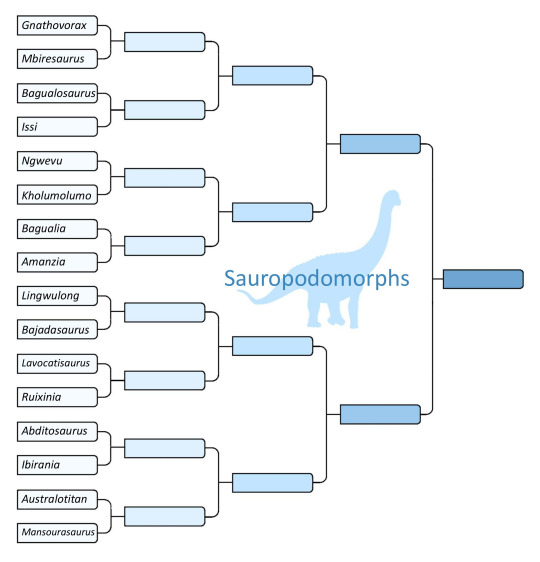
Gnathovorax vs Mbiresaurus
Bagualosaurus vs Issi
Ngwevu vs Kholumolumo
Bagualia vs Amanzia
Lingwulong vs Bajadasaurus
Lavocatisaurus vs Ruixinia
Abditosaurus vs Ibirania
Australotitan vs Mansourasaurus
ORNITHISCHIA
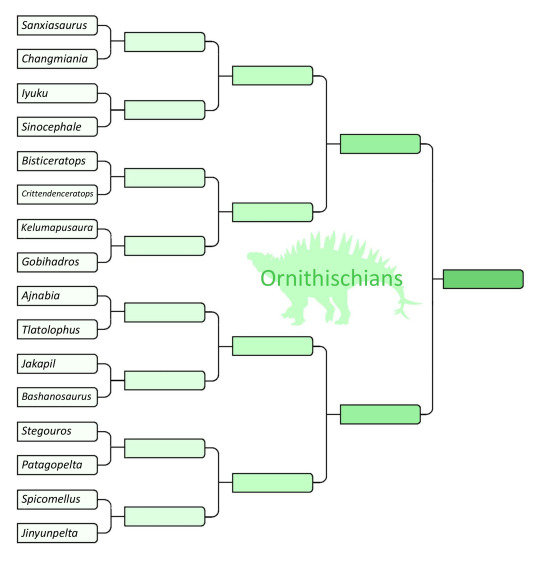
Sanxiasaurus vs Changmiania
Iyuku vs Sinocephale
Bisticeratops vs Crittendenceratops
Kelumapusaura vs Gobihadros
Ajnabia vs Tlatolophus
Jakapil vs Bashanosaurus
Stegouros vs Patagopelta
Spicomellus vs Jinyunpelta
NONAVIAN THEROPODA
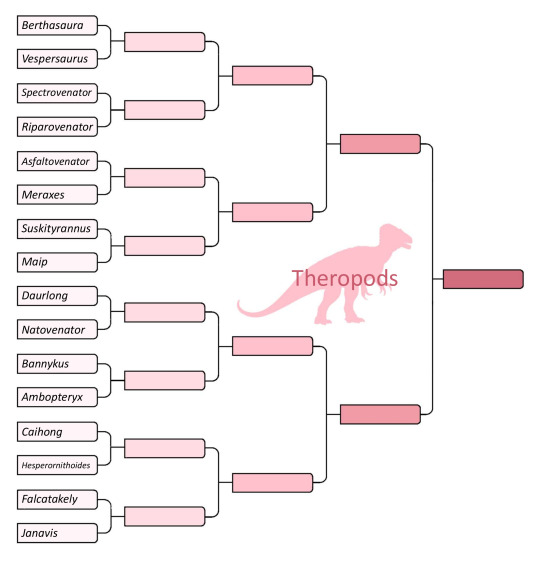
Berthasaura vs Vespersaurus
Spectrovenator vs Riparovenator
Asfaltovenator vs Meraxes
Suskityrannus vs Maip
Daurlong vs Natovenator
Bannykus vs Ambopteryx
Caihong vs Hesperornithoides
Falcatakely vs Janavis
NEORNITHES (BIRDS)

Vorombe vs Prodontopteryx
Asteriornis vs Panraogallus
Anachronornis vs Conflicto
Annakacygna vs Nasidytes
Aviraptor vs Cryptogyps
Miosurnia vs Primoptynx
Danielsraptor vs Heracles
Eofringillirostrum vs Heliothraupis
#dinosaur march madness#dmm#dmm rising stars#palaeoblr#dinosaurs#bracket#polls#march madness#tumblr dinosaur competition#thank you tumblr for making polls dmm is so much easier now I will cry#heliothraupis#eofringillirostrum#heracles#danielsraptor#primoptynx#miosurnia#cryptogyps#aviraptor#nasidytes#annakacygna#conflicto#anachronornis#panraogallus#asteriornis#prodontopteryx#vorombe#janavis#falcatakely#hesperornithoides#caihong
835 notes
·
View notes
Text
Fossil Novembirb 5: It's Getting Hot In Here

Sandcoleus by @drawingwithdinosaurs
Global warming is nothing new for the planet, and even in the Cenozoic we've had our share of rapid warming events - the most notable one being the Paleocene-Eocene Thermal Maximum (PETM). This event, taking place 56 million years ago, was the result of rapid carbon release from the North Atlantic Igneous Province - aka, a volcano exploded, released a bunch of greenhouse gases, and suddenly global temperatures jumped somewhere between 4 and 10 degrees Celsius (depending on location) in a very short period of time - sound familiar?
Given the obvious parallels to the current day, this event has been studied extensively, though only in a few spheres. We know that plants changed dramatically, with broad leafed plants spreading around the world and turning it into a global tropical forest, even at the polls - leading to interesting adaptations towards the strange light cycles at high latitudes. The world was wetter, and greener, and the change lead to the evolution of new herbivory methods in insects. Mammals got smaller, spread everywhere, and diversified. A mass extinction occurred in the oceans, with microorganisms seeing a larger drop in diversity than during the end-Cretaceous extinction. More calcified algae flourished in the more acidic waters.
But what happened to birds?
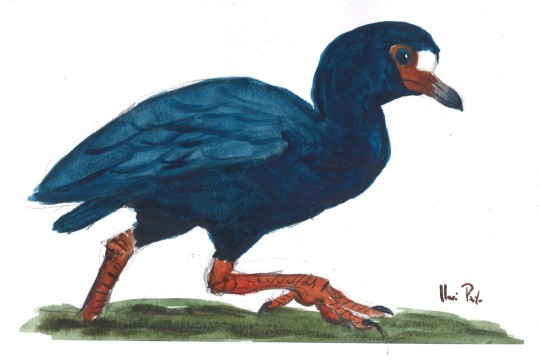
Anachronornis by @otussketching
Turns out, we're not quite sure. Bird fossils before the event are rare, and after are so diverged and varied that it's difficult to know what happened because of the event, and what happened before and just didn't fossilize. Luckily, scientists (... me) are on the case! And there were a few ecosystems that straddle the time around the event, such as the one for this post: the Willwood Formation.
This ecosystem in Wyoming takes place over the late Paleocene through the early Eocene, covering the entire PETM period. And while it showcases many different aspects of this transition, we're of course here for the birds! Not only was there Gastornis, because it was a ubiquitous presence in the Northern Hemisphere following the PETM, there were also many other weird early kinds of birds, all across the avian family tree.

Paracathartes by @drawingwithdinosaurs
Sandcoleus is one of the more notable tree birds from this ecosystem, being a relative of living mousebirds but in North America (rather than Africa, where they are found today). In fact, lots of different tree birds were present, indicating that the current dominance of Passeriformes - so called "perching birds" - was not always the case. In fact, Paracathartes was also present - our first Palaeognath, an early Lithornithid! - and it also may have been able to perch in the trees, and certainly seems to have been a decent flier.
There were also Geranoidids like Palaeophasianus and Paragrus, which were once thought of as pheasant-like and crane-like respectively, but may now actually be Palaeognaths - and some of the earliest known flightless ones to boot! That said, said, other than being long legged flightless birds, we know little about their ecologies - they may have been herbivorous, and as tropical forest dwellers, could have had similar lifestyles to the living cassowary.
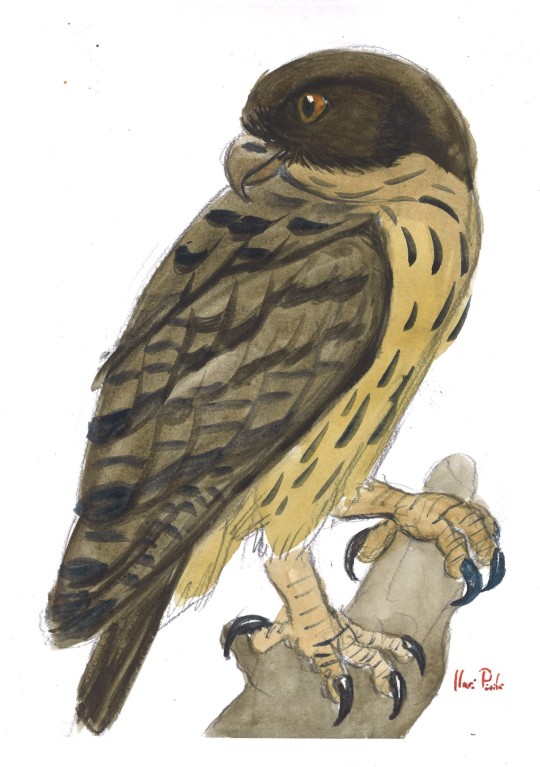
Primoptynx by @otussketching
And, of course, there was also Anachronornis, the half-screamer-half-duck thing, showcasing how waterfowl were experimenting with a variety of different niches during this ecological explosion. And the large variety of new small mammals didn't go unnoticed either - while other early owls are known from Europe, Primoptynx was both the oldest and the biggest, probably thanks to all the new small mammals to eat! There were also possible ground raptors, similar to Bathornis, though they have not been named.
While there are many questions left to answer, it is clear that the PETM had a major effect like it did on everything else on the planet during that time - and the tropical ecologies that they evolved in during the early Eocene would have many implications, especially for where different clades live today!
Sources:
Houde, P., M. Dickson, D. Camarena. 2023. Basal Anseriformes from the Early Paleogene of North America and Europe. Diversity 15 (2): 233.
Mayr, 2022. Paleogene Fossil Birds, 2nd Edition. Springer Cham.
Mayr, 2017. Avian Evolution: The Fossil Record of Birds and its Paleobiological Significance (TOPA Topics in Paleobiology). Wiley Blackwell.
104 notes
·
View notes
Text
Fossil Novembirb 10: Bayou in the Badlands

Fluvioviridavis by @quetzalpali-art
Back to Eocene Ecosystems! One of the most famous Eocene fossil sites in the world is the Fossil Lake site of the Green River Formation, an ecosystem from Colorado in the United States. This ecosystem records the transition from the moist forested world of the early Eocene to the drier warm world of the mid-Eocene. The forests would begin to shrink back, the foliage would change, and so would the animals.
Fossil Lake records the start of that process! Sediment would regularly settle into this lake at periodic intervals, which then recorded the evolution of the lifeforms there over thousands of years. The forests were filled with sycamore trees and other broadleaf plants, as well as ferns.

Limnofregata by @iguanodont
Because the lake was so frequently filled with sediment, oxygen levels were low to nonexistent, preventing decomposers from living at the bottom of the lake. This lead to many different organisms being preserved nearly perfectly, including many gorgeous birds!
In fact, the Field Museum of Chicago - my home - has many of these wonderful fossils on display, and have fascinated me since childhood. So I'm going to break format a little here to showcase some of these fossils.

Cyrilavis, a Halcyornithid (Parrot-Passerine of Prey)
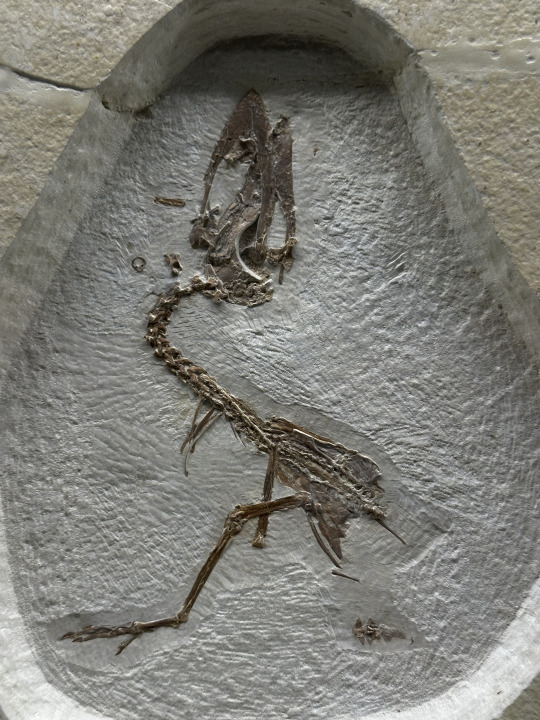
Fluvioviridavis, a Strisorian (like oilbirds or frogmouths)

Eofringillirostrum, a Passerine

Limnofregata, a Frigatebird in a Gull Niche

Nahmavis, a relative of shorebirds (Charadriiformes) or rails and cranes (Gruiformes)
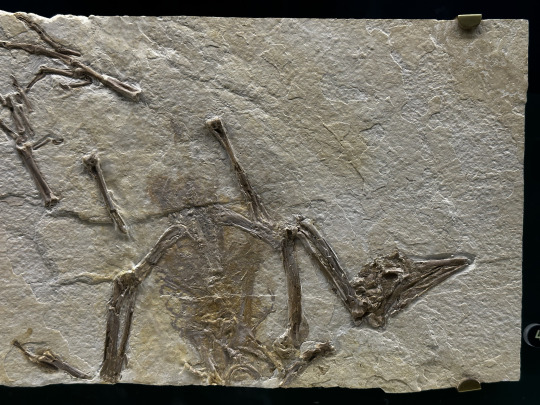
An unnamed Anseriform, probably similar to Anachronornis

Celericolius, a mousebird

Zygodactylus, a stem-passerine
We see once again in this ecosystem - as we have in the others we've covered - the common theme of Avian evolution: the niches may stay the same, but the birds filling them will always change. We have Mousebirds perching in trees in North America, we have Frigatebirds filling the Gull niche, ducks wading around the lake like flamingos, and cousins of parrots/passerines hunting prey.

Presbyornis by @drawingwithdinosaurs
Other notable dinosaurs from this formation include Presbyornis, another one of those Flamingo-Ducks we've talked about like Teviornis and Conflicto; Gastornis because it was literally everywhere from the latest Paleocene through the early Eocene; Lithornithids like Pseudocrypturus because they were also everywhere; early landfowl like Gallinuloides; the cuckoo-roller Plesiocathartes; the ibis Vadaravis; and the turaco relative Foro. Once again, we see many tropical birds in places where they aren't today, due to the extensive warm climate of the Early Eocene.

Foro by @drawingwithdinosaurs
This swampy ecosystem was filled with large crocodile relatives, small mammals, the earliest known bats, giant lizards, and an alarming number of fish - making it one of the better known ecosystems of the early Paleogene. But the best known Paleogene fossil location is still to come...
Sources:
Grande, L. 2013. The Lost World of Fossil Lake: Snapshots from Deep Time. University of Chicago Press.
Mayr, 2022. Paleogene Fossil Birds, 2nd Edition. Springer Cham.
Mayr, 2017. Avian Evolution: The Fossil Record of Birds and its Paleobiological Significance (TOPA Topics in Paleobiology). Wiley Blackwell.
79 notes
·
View notes
Text
Suskityrannus vs Maip
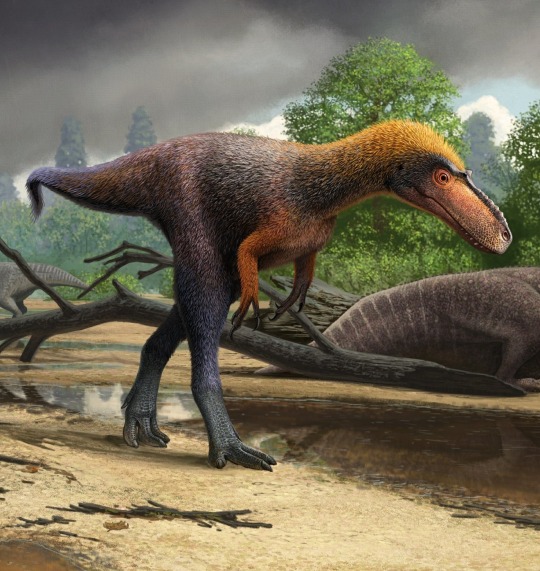

Factfiles:
Suskityrannus hazelae

Artwork by Andrey Atuchin, written by @zygodactylus
Name Meaning: Hazel Wolfe’s Coyote Tyrant
Time: 92 million years ago (Turonian stage of the Late Cretaceous)
Location: Moreno Hill Formation, Zuni Basin, New Mexico
When you follow the progress of paleontology long enough, you start to see things that were previously left undescribed actually get names and the respect they deserve - whether its the “putative screamer” Anachronornis or the “Zuni Coelurosaur” Suskityrannus, you’re sure to get a nice moment and a sense of satisfaction from it. Suskityrannus has been well known for a while due to it being featured in both When Dinosaurs Roamed America as well as Planet Dinosaur. Thought at various times to be a basal Coelurosaur or Tyrannosauroid, its official description placed it somewhat derived within Tyrannosaurs, showcasing the evolution of the Tyrannosaur group as it transitioned from the smaller more speedy forms (like Suskityrannus) to the giant murder birds we know and love later in the Cretaceous. In fact, Suskityrannus lived in an ecosystem that highlighted its changing world, with many early representatives of the later iconic North American Cretaceous ecosystems showing up in early forms in Moreno Hill. Suskityrannus was about one meter tall and three meters long, and already had many adaptations known from later tyrannosaurs. In the forested coastal ecosystem at Moreno Hill, Suskityrannus would have been neighbors with Zuniceratops, Nothronychus, Jeyawati, ankylosaurs, fish, and turtles.
Maip macrothorax

Artwork by @i-draws-dinosaurs, written by @zygodactylus
Name Meaning: Long-chested Shadow of Death
Time: 72 to 66 million years ago (Maastrichtian stage of the Late Cretaceous)
Location: Chorrillo Formation, Patagonia, Argentina
Megaraptors, a group not even really understood a few decades ago, just keep having more and more interesting members added to this group - Maip, a recent addition known from many bones of the trunk and tail, help fill out more of this picture with remains not known from other Megaraptors, and als having the most complete Megaraptor skeleton known. Maip was also interesting in having a very long, thick torso, leading to its specific name. It probably reached 9 to 10 meters in length in life, making it the largest Megaraptor known (literally reaching carcharodontosaurid size), and it may indicate that megaraptors rose to high-level predator status as other top predators went extinct in the region. It had a respiratory system similar to modern birds, with unidirectional air flow, much like other Saurischian dinosaurs. Living in southernmost South America, Maip would have had to deal with a variety of harsh climates, and may have been covered in feathers in order to keep warm. In addition to mosasaurs, snakes, turtles, mammals, fish, and frogs, Maip lived with other dinosaurs such as Nullotitan, Kookne, Yatenavis, and Isasicursor.
DMM Round One Masterpost
#dmm#dinosaur march madness#dmm round one#dmm rising stars#palaeoblr#dinsoaurs#paleontology#bracket#march madness#polls#suskityrannus#maip
265 notes
·
View notes
Text
If you wish to boop me, you may do so on my account blog @anachronornis (I never use it, don’t bother following)
45 notes
·
View notes